Domesticated turkey
Conservation status: Domesticated |
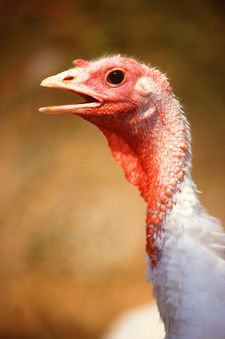
Large White Turkey
|
|
Scientific classification |
| Kingdom: |
Animalia
|
| Phylum: |
Chordata
|
| Class: |
Aves
|
| Order: |
Galliformes
|
| Family: |
Meleagrididae
|
| Genus: |
Meleagris
|
|
| Species |
Meleagris gallopavo (modern)
Meleagris ocellata (historical) |
The domesticated turkey is a large
poultry
bird raised for food. The modern domesticated turkey
descends from the wild turkey (Meleagris gallopavo), one of
the two species of turkey (genus Meleagris); however, in the
past the ocellated turkey (Meleagris ocellata) was also
domesticated. Despite the name, turkeys have no relation to
the country of Turkey and are instead native to North
America.
The turkey is reared throughout temperate parts of the
World, and is a popular form of poultry, partially because
industrialised farming has made it very cheap for the amount
of meat it produces. The female domesticated turkey is
referred to as a hen and the chick as a poult.
In the
United States, the male is referred to as a tom, whilst in
Europe, the male is a stag.
The great majority of domesticated turkeys have white
feathers, although brown or bronze-feathered varieties are
also raised.
History
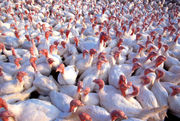
Turkeys
Turkeys were brought back to Europe shortly after their
discovery in the New World. For this reason, many distinct
turkey breeds were developed in Europe due to cross
breeding. (e.g. Spanish Black, Royal Palm). Turkey was one
of the many game species hunted by early American colonists
and is traditionally (though not in actuality) thought to
have been served at the first Thanksgiving. Turkeys have
been a staple on farms since their discovery in colonial
times. In the midwestern United States in the mid to late
1800s, domestic turkeys were actually herded across the
range in a manner similar to herding cattle. In the early
20th century, many advances were made in the breeding of
turkeys resulting in varieties such as the
Beltsville Small White.
Suggestions have been made that the Mexican
Ocellated Turkey (Meleagris ocellata) might also
be involved, but the plumage of domestic turkeys does not
support this theory; in particular, the chest tuft of
domestic turkeys is a clear indicator of descent from the
Wild Turkey (the Ocellated Turkey does not have this tuft)
Availability and Commercial Production
Prior to World War II, turkey was something of a luxury
in Britain, with goose or beef a more common Christmas
dinner [1] (In Charles Dickens' A Christmas Carol Bob
Cratchit had a goose before Scrooge bought him a turkey).
Intensive farming of turkeys from the late 1940s, however, dramatically cut the price and it became
far and away the most common Christmas dinner meat. With the
availability of refrigeration, whole turkeys could be
shipped frozen to distant markets. Later advances in control
of disease increased production even more. Advances in
shipping, changing consumer preferences and the
proliferation of commercial poultry plants for butchering
animals has made fresh turkey available to the consumer.
Approximately two to four billion pounds of poultry
feathers are produced every year by the poultry producing
industry. Most of the feathers are usually ground up and
used as filler for animal feed. Researchers at the United
States Department of Agriculture (USDA) have patented a
method of removing the stiff quill from the fibers which
make up the feather. As this a potential untapped supply of
natural fibers, research has been conducted at Philadelphia
University to determine textile applications for feather
fibers. To date, turkey feather fibers have been blended
with nylon and spun into yarn which was then used for
knitting. The yarns were tested for strength while the
fabrics were evaluated as potential insulation materials. In
the case of the yarns, as the percentage of turkey feather
fibers increased the strength decreased. In fabric form, as
the percentage of turkey feather fibers increased the heat
retention capability of the fabric increased.
Breeding
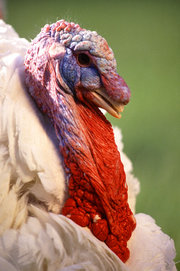
Large White turkey male
Modern animal husbandry has resulted in significant
differences between wild turkeys and commercial farm
animals. Broad-breasted varieties are prized for their white
meat, fast growth, and excellent feed-conversion ratios.
Broad-breasted varieties are typically produced by
artificial insemination to avoid injury of the hens by the
much larger toms and because the physical changes resulting
in broad (double) breasts have also rendered most males
incapable of natural mating. Modern commercial varieties
have also lost much of their natural ability to forage for
food, fly, walk normally, and to escape predators. For this
reason, many non-commercial hobbyists as well as organic
farmers grow "heritage" breeds such as the Royal Palm or
Naragansett -- varieties traditionally grown on farms prior
to the advent of large-scale agriculture. Heritage breeds do
not grow as quickly as commercial breeds and are
single-breasted and thus have less white meat. Their meat
has a much stronger turkey taste and does not require flavor
additives or brining. Heritage turkeys are disease
resistant, strong flyers and foragers, and can mate
naturally and raise their young successfully.
Male turkeys strut and demonstrate, usually in groups, to
attract hens. They fan out their tail, puff up the feathers
on their backs, and drag their primary flight feathers on
the ground to produce a "scraping" sound. Part of the
demonstration includes gobbling and producing a "puff" sound
followed by a very low resonating "boing" that sounds like a
rubber band in an echo chamber. The low resonating sound is
low enough that it cannot be captured with traditional audio
equipment. The hen in turn makes a "yelp" or call that
attracts the males. Hens select their mate and crouch on the
ground with neck extended to signal their willingness to
mate. Hens continue to lay fertile eggs for three to four
weeks from just one mating. However, when given the
opportunity hens will mate everyday.
Some commercial turkey hens occasionally produce young
from unfertilized eggs in a process called
parthenogenesis.
Most Domesticated turkeys are grain fed.
Butchering
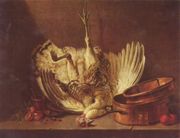
Still life with hanging turkey,
Jean-Baptiste Siméon Chardin, 2nd third of 18th
century.
To kill a live turkey, withhold food for a day to help
ensure the digestive system is empty. (Some recommend also
feeding the turkey hard liquor before slaughter, both to
sedate it and perhaps as a way of flavoring the meat.)
Putting the turkey in a bag, with one corner cut out for the
head, helps keep the turkey from thrashing and damaging
itself or the people involved in preparing it. One method is
to hammer two nails into a stump and bend them, then put the
turkey's head on the stump and turn the nails to hold the
turkey's head still, then remove the turkey's head with an
axe. The turkey will thrash for a few moments. More
commonly, a turkey is placed upside down inside a metal cone
manufactured for this purpose, its neck is cut, and the
blood is allowed to drain out. At this point, a process
known as debraining may be applied, where the brain stem is
severed by pushing a sharp knife or screwdriver in to the
mouth and through the back of the throat towards the base of
the skull and applying a twisting motion. Successful
debraining will generally result in a bird that is easier to
pluck.
Hang the carcass upside down to bleed for a half hour or
so. When bleeding is complete, the bird can be manually
plucked, which gives a good quality carcass. Smaller
feathers can be pulled off in a bunch; larger feathers need
to be removed one at a time so as not to tear the skin.
Stubborn feathers can be pulled with pliers or a forceps.
The alternative is to scald the carcass in hot water for 1-3
minutes at a temperature of 60-80ºC before manual plucking.
This greatly reduces the amount of labor required to remove
the feathers, but care must be taken to avoid accidentally
"cooking" the skin. When all the feathers are removed, rinse
the turkey's anus to remove any residue, then insert a sharp
knife just below the hip bone, but not so deep as to
puncture any of the internal organs. Cut down and around on
either side of the anus, making sure it's angled up to keep
any excretion off the meat. Carefully pull out and discard.
Then reach inside the turkey and remove all organs, as well
as large globs of fat. If desired, the heart, liver (slice
away from other innards, being careful not to puncture the
green gall), and gizzard can be saved for giblets. If the
gizzard is saved, slice it in half until the gravel inside
grates against the knife, then slice around and open up,
peeling away the inner layer and discarding the contents.
After all the organs have been removed, turn the turkey
around and cut around the circumference of the neck and peel
down, exposing the esophogus and windpipe. For each,
separate them from their attachment points and pull them
out, including the crop in the case of the esophogus. Rinse
the turkey out with cold water and, if desired, hang and
chill for a day or so before freezing.
Turkeys as food
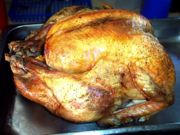
Eating cooked turkey on holidays, especially
Thanksgiving, is a common North American
tradition.
Turkeys are traditionally eaten as the main course of
large feasts at
Christmas
in Europe and North America, as well as Thanksgiving in the
United States and Canada, in both cases having displaced the traditional
goose. While eating turkey was once mainly restricted to
special occasions such as these, turkey is now eaten year
round and forms a regular part of many diets.
In countries where turkey is popular, it is available
commonly in
supermarkets. Turkeys are sold sliced and ground, as
well as "whole" in a manner similar to
chicken with the head, feet, and feathers removed.
Frozen whole turkeys remain popular. Sliced turkey is
frequently used as a sandwich meat or served as cold cuts. Ground turkey is sold just as ground beef,
and is frequently marketed as a healthy beef substitute.
Without proper preparation, turkey is usually considered to
end up less moist than, say,
chicken or
duck. Leftovers from roast turkey are generally served
as
cold cuts on
Boxing Day.
Wild turkeys, while technically the same species as
domesticated turkeys, have a very different taste from
farm-raised turkeys. Almost all of the meat is "dark" (even
the breasts) with a more intense turkey flavor. Older
heritage breeds also differ in flavor.
Turkey is often found as a processed meat. It can be
smoked and as such is sometimes sold as turkey ham. Twisted
helices of turkey meat sold as turkey twizzlers came to
prominence in the UK in 2004 when chef Jamie Oliver
campaigned to have them and similar foods removed from
school dinners.
Cooking
Both fresh and frozen turkeys are used for cooking; as
with most foods, fresh turkeys are generally preferred,
although they cost more. Around
holiday seasons, high demand for fresh turkeys often
makes them difficult to purchase without ordering in
advance. However, the large size of the turkeys typically
used for consumption makes defrosting them a major endeavor:
a typically-sized turkey will take several days to properly
defrost.
Turkeys are usually baked or roasted in an oven for
several hours, often while the cook prepares the rest of the
meal. Sometimes, a turkey is brined before baking to enhance
flavor and moisture content. In some areas, particularly the
American South, they may also be deep fried in hot oil
(often peanut oil) for 30 to 45 minutes by using a turkey
fryer. Deep frying turkey has become something of a fad,
with hazardous consequences for those unprepared to safely
handle the large quantities of hot oil required.
[2]
Accompaniments
For
Christmas in Britain, turkey is traditionally served
with winter vegetables including roast
potatoes, Brussels sprouts, and parsnips. Cranberry sauce is
the traditional condiment in the northern rural areas of
Britain where wild cranberries grow. In the south and in
urban areas, where cranberries until recently were difficult
to obtain, bread sauce was used in its place, but the
availability of commercial cranberry sauce has seen a rise
in its popularity in these areas too. Sometimes sausagemeat,
cocktail sausages or liver wrapped in bacon is also served
(known as bacon rolls or "pigs in blankets").
Especially during holiday seasons, stuffing is
traditionally served with turkey. There are many varieties:
oatmeal, chestnut, sage and onion (flavoured bread), and
sausage (possibly with mashed potato) are the most traditional. Stuffing may
either be used to stuff the turkey (as the name implies), or
may be cooked separately and served as a side dish.
For
Thanksgiving in the United States and Canada, turkey is
traditionally served with cranberry sauce and gravy. Other
items vary, but common complementary dishes include mashed
potatoes, dinner rolls, various vegetables (such as corn,
green beans, squash, and sweet potatoes), and various types
of pie for dessert (such as pumpkin, apple and pecan). One
humorous decades-old Thanksgiving tradition in the United
States is the annual Presidential "pardon" of a selected
turkey, which meets with the President and then is taken to
a petting zoo instead of a slaughterhouse.
Health concerns
Turkey is generally considered healthier and less
fattening than red meat. Turkey is high in
tryptophan, and is commonly credited with causing
sleepiness after a meal, however this is largely a
misconception. Turkey dinners are commonly large meals
served with carbohydrates, fats, and alcohol in a relaxed
atmosphere, all of which are bigger contributors to
post-meal sleepiness than the tryptophan in turkey.[1]
Turkeys in culture
Norman Rockwell featured a roast turkey as a symbol of
prosperity in his painting "Freedom from Want", one of his
Four Freedom Series.
Turkey dung for fuel
Turkey droppings are planned to fuel an electric power
plant in western Minnesota. The plant will provide 55
megawatts of power using 700,000 tons of dung per year.
Plant will begin operating in 2007. Three such plants are in
operation in England.[3]
References
External links




